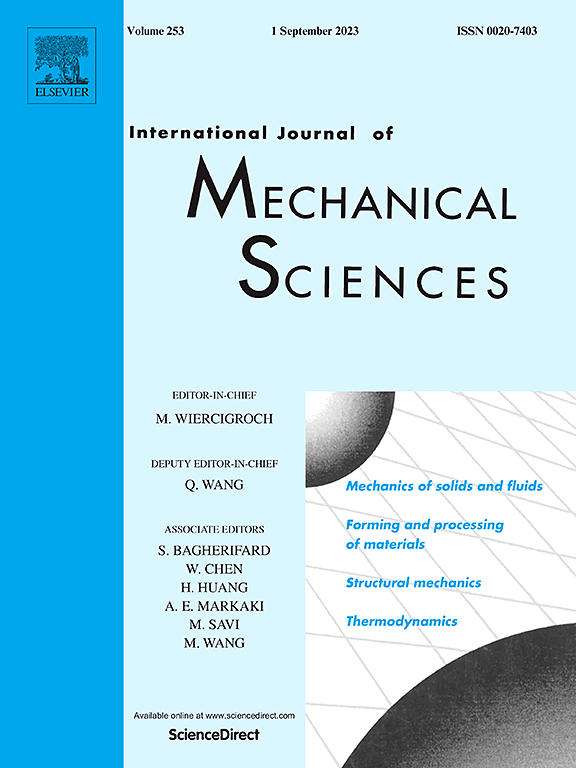Investigation on the hysteresis behavior of a quarter-wavelength standing-wave thermoacoustic engine
IF 7.1
1区 工程技术
Q1 ENGINEERING, MECHANICAL
International Journal of Mechanical Sciences
Pub Date : 2025-02-19
DOI:10.1016/j.ijmecsci.2025.110084
引用次数: 0
Abstract
Like many nonlinear dynamical systems, thermoacoustic engines (TAEs) exhibit hysteresis behavior in the amplitude of self-excited acoustic oscillations when the temperature gradient implemented across the porous material is first increased and then decreased gradually. This research studies the hysteresis of a quarter-wavelength standing-wave TAE that relies on a parallel plate stack to realize thermal-acoustic energy conversion. Computational fluid dynamics (CFD) is first employed to investigate the influence of stack parameters, such as stack gap and position, on the hysteresis behavior of the TAE. Following this, in analogy with the modeling of Rijke tubes, a simplified mathematical model of the TAE is developed to provide a qualitative interpretation of the hysteresis curves obtained from the CFD simulations. Finally, experimental tests are conducted to validate the presence of hysteresis in the TAE. Results show that in the bistable zone, the dynamic behavior of the TAE can be either linearly stable fixed points or limit cycles. An external pressure disturbance or energy sink can be applied to alter the dynamics of the TAE. There exist optimal values for the stack gap and position at which the lower and upper critical temperatures, as well as their difference, are minimized. At the optimal stack gap, the pressure amplitude reaches its minimum. However, as the stack is shifted toward the open end, the pressure amplitude gradually decreases, highlighting a trade-off between reducing the onset temperature difference and improving acoustic power generation. The present study gives deeper insights into the hysteresis phenomena reported in previous experimental studies, providing useful guidelines for reducing the critical temperature gradients for the excitation of acoustic oscillations in TAEs.

求助全文
约1分钟内获得全文
求助全文
来源期刊

International Journal of Mechanical Sciences
工程技术-工程:机械
CiteScore
12.80
自引率
17.80%
发文量
769
审稿时长
19 days
期刊介绍:
The International Journal of Mechanical Sciences (IJMS) serves as a global platform for the publication and dissemination of original research that contributes to a deeper scientific understanding of the fundamental disciplines within mechanical, civil, and material engineering.
The primary focus of IJMS is to showcase innovative and ground-breaking work that utilizes analytical and computational modeling techniques, such as Finite Element Method (FEM), Boundary Element Method (BEM), and mesh-free methods, among others. These modeling methods are applied to diverse fields including rigid-body mechanics (e.g., dynamics, vibration, stability), structural mechanics, metal forming, advanced materials (e.g., metals, composites, cellular, smart) behavior and applications, impact mechanics, strain localization, and other nonlinear effects (e.g., large deflections, plasticity, fracture).
Additionally, IJMS covers the realms of fluid mechanics (both external and internal flows), tribology, thermodynamics, and materials processing. These subjects collectively form the core of the journal's content.
In summary, IJMS provides a prestigious platform for researchers to present their original contributions, shedding light on analytical and computational modeling methods in various areas of mechanical engineering, as well as exploring the behavior and application of advanced materials, fluid mechanics, thermodynamics, and materials processing.
 求助内容:
求助内容: 应助结果提醒方式:
应助结果提醒方式:


